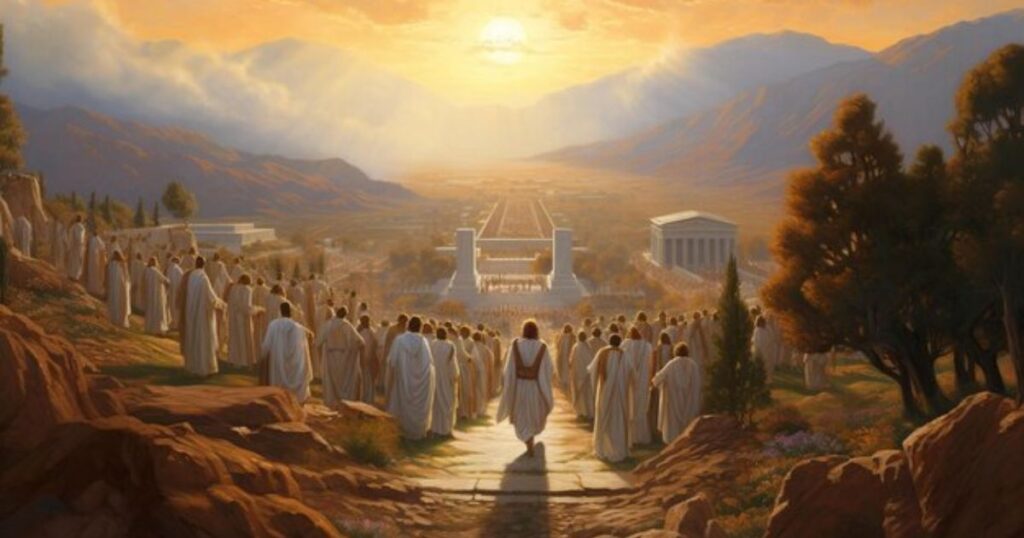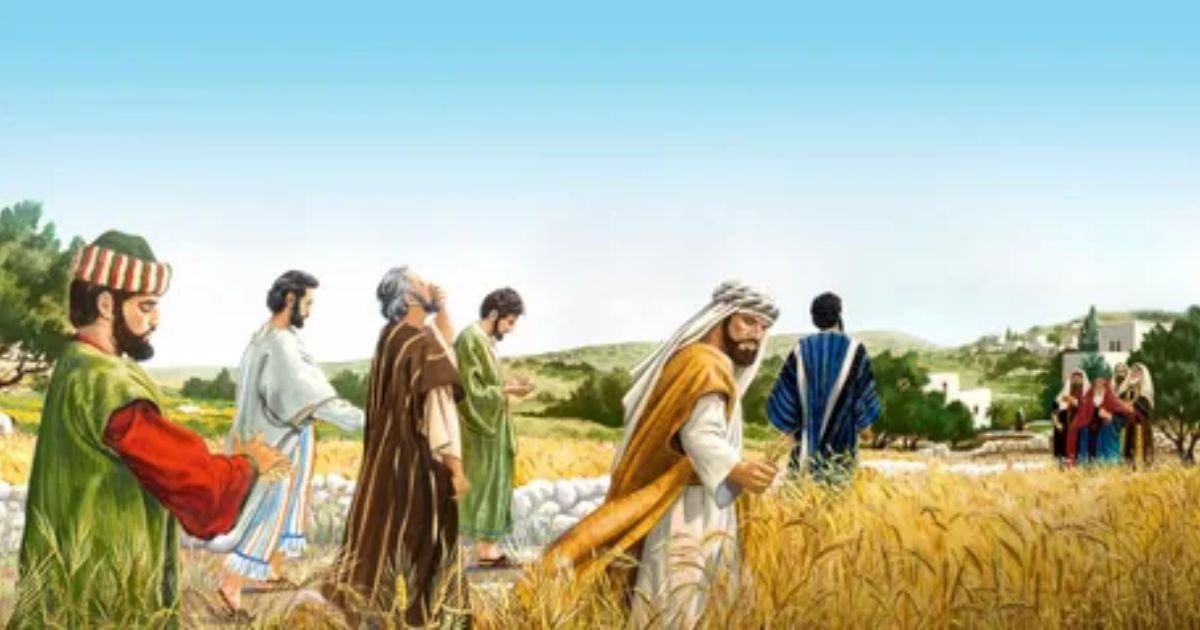The gap between Adam and Jesus is a topic that often sparks curiosity and contemplation among Christians. The Bible provides a timeline that spans thousands of years, but many wonder about the significance of this period and its impact on salvation history. Understanding this gap helps us appreciate the unfolding of God’s plan for humanity, from the creation of Adam to the arrival of Jesus as the Savior.
In this exploration, we’ll look closely at the gap between Adam and Jesus and its spiritual implications. Through biblical analysis, we can gain insight into how God’s promises and covenants were fulfilled over generations. The time between these two pivotal figures is crucial in understanding the progression of salvation and the fulfillment of God’s redemptive plan through Christ.
The Time Gap Between Adam and Jesus: A Biblical Analysis for Christians
According to the Bible, the timeline from Adam to Jesus spans several generations and significant events. From Adam to Jesus, there are approximately 4,000 years. This timeline includes key figures such as Abraham, Moses, and David, leading up to the birth of Jesus Christ. The genealogies in the Bible help us trace this lineage from the first man, Adam, to the Savior, Jesus.
The gap between Adam and Jesus serves as a bridge in the unfolding of God’s plan for redemption. From the moment of Adam’s fall, God’s covenant with humanity began to take shape. The story from Adam to Jesus shows the necessity of a Savior, someone who would bridge the divide caused by sin.
Throughout the centuries, the gap between Adam and Jesus was marked by key promises from God. Adam’s fall created the need for a redeemer, and through figures like Abraham, the promise of a coming Savior was established. This gap helped to prepare the world for the fulfillment of God’s promise.
- Key biblical figures played essential roles in preparing for the arrival of Jesus. From Adam, the father of humanity, to Abraham, the father of faith, the gap between Adam and Jesus was marked by God’s continual work in the world. These figures laid the foundation for the coming of Christ.
- The period between Adam and Jesus also highlights humanity’s constant struggle with sin and the need for a Savior. This gap between Adam and Jesus is marked by humanity’s repeated failures to keep God’s laws. Despite this, God remained faithful to His promises.
- The gap between Adam and Jesus is not just a chronological timeline but a story of grace. It reveals how, even in the face of sin, God’s plan for salvation was always in motion. Through prophets and covenants, God paved the way for the coming of His Son.
- During this time, the Jewish people awaited the Messiah, prophesied to bring salvation. The gap between Adam and Jesus also highlights the anticipation of a Savior who would not only deliver Israel but also offer redemption to the entire world. This hope was fulfilled in the person of Jesus Christ.
- The teachings and lives of the patriarchs provide a deeper understanding of the gap between Adam and Jesus. By looking at the faith of figures like Noah and Moses, we see how God’s redemptive plan unfolded. These men were faithful to God’s promises, even when the Messiah had not yet come.
- The genealogies in the Bible are an important part of understanding the gap between Adam and Jesus. These genealogies show how God’s promise to send a Savior was passed down through generations. Each person listed in these genealogies played a role in fulfilling God’s purpose.
- The gap between Adam and Jesus ultimately points to the fulfillment of God’s promises through Jesus Christ. It’s a reminder that God’s plan for salvation has always been consistent and faithful. From the first man, Adam, to the Savior of the world, Jesus, God’s purpose was clear all along.
- Understanding the gap between Adam and Jesus helps us see the continuity in God’s redemptive work. It’s a testament to His unchanging love for humanity and His commitment to saving us through Christ. The time between these two pivotal figures reveals the deep faithfulness of God in fulfilling His promises.
Related Guide:
Unlocking the Mystery of 39 Lashes: A Deep Dive into Biblical Punishment
How does the timeline from Adam to Jesus impact our understanding of Biblical history?

According to the Bible, the timeline from Adam to Jesus spans several generations and significant events. From Adam to Jesus, there are approximately 4,000 years. This timeline includes key figures such as Abraham, Moses, and David, leading up to the birth of Jesus Christ. The genealogies in the Bible help us trace this lineage from the first man, Adam, to the Savior, Jesus.
The gap between Adam and Jesus is crucial to understanding God’s plan for humanity. It shows the unfolding of salvation history, where God’s promise to send a Savior was established. By tracing the events from Adam to Jesus, we see how the need for redemption grew throughout history.
The gap between Adam and Jesus also reflects the progression of God’s covenants with humanity. From Adam’s fall to God’s promises to Abraham, Moses, and David, each step in the timeline prepares the world for the coming Messiah. These covenants were milestones in God’s larger redemptive plan.
- The gap between Adam and Jesus provides a deeper understanding of God’s faithfulness. Despite humanity’s failures, God remained committed to His promise. The timeline demonstrates how God’s plan was carried out, even in the face of sin and disobedience.
- This timeline helps us understand the importance of the law and the prophets. The gap between Adam and Jesus shows the need for a Savior to fulfill the law perfectly. Figures like Moses and the prophets point to the coming of Christ, who would bring ultimate redemption.
- The gap between Adam and Jesus also highlights the anticipation of the Messiah. For centuries, the Jewish people awaited a Savior who would redeem them from sin and oppression. Understanding this anticipation gives us a fuller appreciation of the arrival of Jesus as the long-awaited Messiah.
- By looking at the gap between Adam and Jesus, we see the unfolding of God’s redemptive plan through the nation of Israel. From Adam’s fall to the exile of Israel, each event in this timeline played a role in preparing the world for the Savior. God’s patience and faithfulness are evident throughout this period.
- The genealogies in the Bible, which trace the gap between Adam and Jesus, are essential for understanding how Jesus fits into God’s plan. These genealogies show that Jesus is the fulfillment of God’s promises to His people, confirming His rightful place in history as the promised Savior.
- The gap between Adam and Jesus also teaches us about the nature of sin and redemption. From Adam’s sin to the need for a Savior, this timeline reveals the extent of humanity’s fall and the grace of God in sending Jesus to redeem us. It underscores the importance of Jesus’ sacrifice.
- As we explore the gap between Adam and Jesus, we see how God’s sovereignty is at work in every generation. Even when it seemed like God’s plan was delayed, His promises were always faithful. Jesus’ arrival marked the fulfillment of God’s plan that had been in motion since Adam.
- In conclusion, understanding the gap between Adam and Jesus helps us see the continuity in God’s redemptive plan. It demonstrates that God’s purpose for salvation has always been clear, with Jesus as the fulfillment of promises made long ago. This timeline strengthens our faith and helps us appreciate the depth of God’s love for humanity.
How many years have passed from Adam to today based on the Biblical timeline?
From Adam to today, according to the Biblical timeline, it has been approximately 6,000 years. This time span encompasses the creation of the world, the fall of humanity, the establishment of covenants with key figures like Abraham and Moses, and ultimately, the birth, death, and resurrection of Jesus Christ. The Bible provides a comprehensive timeline that connects the beginning of time with the present day.
The gap between Adam and Jesus is a significant point in understanding the passage of time according to Scripture. It is believed that about 4,000 years passed from Adam to the birth of Jesus Christ. This timeline is derived from the genealogies outlined in the Bible, particularly in the books of Genesis, Matthew, and Luke.
One of the key reasons the gap between Adam and Jesus is important is that it marks the unfolding of God’s plan of salvation. The history of Israel and the arrival of Jesus fit into this span of time, demonstrating how God worked through various generations to prepare for the Savior.
- Understanding the gap between Adam and Jesus also allows us to grasp the significance of key Biblical events. From the fall of Adam to the covenant with Noah, the timeline reveals God’s judgment, mercy, and promise to restore humanity, eventually culminating in the coming of Jesus.
- The gap between Adam and Jesus also highlights the importance of the genealogies found in the Bible. These genealogies trace the lineage from Adam to Jesus, showcasing God’s faithfulness in keeping His promises across generations. This timeline serves as a testimony to God’s plan for the redemption of the world.
- In considering the gap between Adam and Jesus, we also see the significance of the law and the prophets. These figures prepared the way for Jesus’ arrival by establishing a framework for understanding sin, justice, and the need for a Savior.
- The gap between Adam and Jesus is not only a historical timeline but a theological one as well. It reveals how God worked through history to bring about the fulfillment of His promise to send a Redeemer. From Adam’s fall to the coming of Christ, every event plays a part in this grand narrative of salvation.
- Based on the gap between Adam and Jesus, we can also consider the importance of the spiritual lessons taught during this time. From the teachings of the patriarchs to the commandments given through Moses, each period in this timeline serves to guide humanity toward the knowledge of God and His plan for redemption.
- As we reflect on the gap between Adam and Jesus, it is clear that the Biblical timeline is not merely a record of events but a testimony of God’s ongoing work in the world. The timeline from Adam to Jesus is filled with moments that reveal God’s righteousness, mercy, and promise of salvation through Christ.
- In conclusion, understanding the gap between Adam and Jesus provides a clearer perspective on how God’s timeline leads to the present day. The history recorded in the Bible, spanning roughly 6,000 years, is a testament to God’s faithfulness, His promises, and His ultimate plan for the redemption of mankind through Jesus Christ.
How many years separate Abraham from Jesus in the Bible’s timeline?
In the Bible’s timeline, there are approximately 2,000 years between Abraham and Jesus. Abraham, known as the father of faith, lived around 2,000 years before the birth of Jesus Christ. His faithfulness and obedience to God set the stage for the covenant relationship between God and His people, leading to the fulfillment of that covenant in the person of Jesus.
The gap between Abraham and Jesus highlights a period of incredible significance in biblical history. During these 2,000 years, God’s covenant with Abraham was expanded and deepened through generations of his descendants. These generations, including key figures such as Isaac, Jacob, and David, paved the way for the coming of Jesus.
The gap between Abraham and Jesus also represents a time of anticipation and promise. God’s promises to Abraham about his descendants becoming a great nation were realized through Israel, and the coming of Jesus fulfilled God’s promise to send a Savior to redeem humanity.
- Throughout this gap between Abraham and Jesus, the people of Israel experienced periods of prosperity and suffering. The story of the Israelites leading up to Jesus’ birth demonstrates God’s faithfulness to His promises, despite the trials and tribulations of the people.
- During this time, the gap between Abraham and Jesus saw the establishment of the law through Moses, which played a key role in preparing the world for the ultimate fulfillment of God’s plan in the form of Jesus Christ. Jesus’ life and ministry brought a new understanding of God’s law, demonstrating grace and truth.
- The gap between Abraham and Jesus also includes the establishment of the Davidic kingdom. God’s covenant with David promised that a descendant of his would rule forever, a promise fulfilled in the person of Jesus Christ, the King of Kings.
- The 2,000 years of history between Abraham and Jesus demonstrate God’s unfolding plan for salvation. This gap between Abraham and Jesus reflects God’s progressive revelation, preparing the world for the redemption that would come through Jesus Christ.
- Prophets such as Isaiah and Jeremiah arose during the gap between Abraham and Jesus, delivering messages of hope and warning. These prophetic voices pointed toward the coming Messiah, whose birth, life, death, and resurrection would fulfill the ancient promises made to Abraham.
- As we consider the gap between Abraham and Jesus, we see how God worked through history to bring His people closer to Him. The story of Israel leading up to the birth of Jesus serves as a powerful testimony of God’s faithfulness, grace, and love.
- In conclusion, the gap between Abraham and Jesus is a critical period in understanding the full narrative of the Bible. It connects the promises made to Abraham with their ultimate fulfillment in the person of Jesus, showing the continuity of God’s plan for salvation through the ages.
What key events and figures are significant in the timeline from Adam to Jesus?
The timeline from Adam to Jesus is marked by key events and figures that shape the narrative of redemption in the Bible. From Adam to Jesus, we encounter pivotal moments such as the Fall of humanity, the Flood during Noah’s time, the establishment of the Abrahamic covenant, the exodus from Egypt led by Moses, and the reign of King David. Each of these events and figures plays a crucial role in God’s plan of salvation culminating in the birth of Jesus Christ.
One of the first significant events in the gap between Adam and Jesus is the Fall of humanity in the Garden of Eden. Adam and Eve’s disobedience brought sin into the world, setting the stage for God’s redemptive plan that would unfold over thousands of years.
The gap between Adam and Jesus also includes the story of Noah and the Flood. God chose Noah to preserve humanity and His creation, providing a new beginning for the earth after it was wiped clean of wickedness. This event foreshadowed God’s desire to redeem His people.
- Abraham, another key figure in the gap between Adam and Jesus, is known for his unwavering faith. God promised Abraham that his descendants would become a great nation and that through them, all nations would be blessed. This promise was a precursor to the coming of Jesus.
- The establishment of the Abrahamic covenant is crucial in the gap between Adam and Jesus because it laid the foundation for Israel’s future role in salvation history. The covenant pointed toward the coming Messiah who would bring blessing to the world.
- Another significant event in the gap between Adam and Jesus is the Exodus, where God used Moses to lead the Israelites out of slavery in Egypt. The Exodus marked the birth of the nation of Israel and is foundational to understanding God’s relationship with His people.
- King David is a central figure in the gap between Adam and Jesus. God promised David that his descendants would rule forever, a prophecy fulfilled in Jesus, who is often referred to as the “Son of David.” This promise ties Jesus’ lineage to the throne of Israel.
- The gap between Adam and Jesus also includes the era of the prophets. Figures like Isaiah and Jeremiah spoke of the coming Messiah, prophesying about His birth, suffering, and ultimate triumph. These prophecies pointed directly to Jesus Christ as the fulfillment of God’s plan.
- Throughout the gap between Adam and Jesus, God’s people experienced cycles of faithfulness and rebellion. The history of Israel highlights the need for a Savior, and this need was fulfilled in the person of Jesus Christ, who came to restore the broken relationship between God and humanity.
- The reign of King Herod, during which Jesus was born, marks the final event in the gap between Adam and Jesus. Herod’s rule over Judea set the stage for the birth of the Savior, who would come not as an earthly king but as the King of Kings.
- In summary, the gap between Adam and Jesus is marked by numerous key events and figures that demonstrate God’s faithfulness and His unfolding plan of redemption. From Adam’s fall to Jesus’ birth, these events show God’s preparation of the world for the coming of the Messiah.
How does the timeline from Adam to Jesus demonstrate God’s overarching plan of redemption?

The timeline from Adam to Jesus serves as a testament to God’s overarching plan of redemption for humanity. Through the generations and events leading up to the birth of Jesus Christ, we witness God’s faithfulness, mercy, and grace in orchestrating His plan of salvation. The timeline reveals the intricate tapestry of history woven by God’s sovereign hand to bring about the redemption of His people through Jesus.
From the very beginning, the gap between Adam and Jesus demonstrates God’s plan for redemption. After the fall of humanity in the Garden of Eden, God promised a Savior who would defeat sin and restore the broken relationship between God and humanity. This promise laid the foundation for the entire narrative of salvation.
As we move through the gap between Adam and Jesus, we see the covenant God made with Abraham. God promised Abraham that his descendants would become a great nation, through which all nations would be blessed. This promise pointed directly to Jesus, the ultimate fulfillment of God’s plan.
- The Exodus, a key event in the gap between Adam and Jesus, showcases God’s faithfulness to His people. Through Moses, God led the Israelites out of Egypt, demonstrating His power to deliver and redeem His people, a foreshadowing of the ultimate deliverance through Jesus Christ.
- The gap between Adam and Jesus also includes the establishment of the Law through Moses. While the Law pointed out humanity’s sin, it also highlighted the need for a Savior. Jesus, who fulfilled the Law, would become the perfect sacrifice for sin, offering true redemption to all who believe.
- The prophecies of the Messiah throughout the gap between Adam and Jesus further demonstrate God’s plan of redemption. Prophets like Isaiah and Micah spoke of a coming Savior who would bring peace and salvation. These prophecies pointed directly to Jesus, whose life, death, and resurrection fulfilled God’s promises.
- King David’s reign in the gap between Adam and Jesus further illustrates God’s plan. God promised David that his throne would be established forever, and this promise was ultimately fulfilled in Jesus, who was born into David’s lineage and would reign forever as King of Kings.
- The genealogies in the gap between Adam and Jesus provide a clear line of descendants that lead directly to Jesus. These genealogies show that God’s plan was not random but carefully orchestrated throughout history, with each generation fulfilling a purpose in the broader plan of salvation.
- The cycles of sin and redemption throughout the gap between Adam and Jesus show humanity’s inability to save itself. Yet, God’s plan was never derailed. Each failure pointed to the need for a Savior, and Jesus became the answer to that need.
- In the gap between Adam and Jesus, God’s faithfulness is evident despite humanity’s unfaithfulness. The story of Israel’s rebellion and return to God mirrors the larger narrative of God’s ongoing pursuit of redemption for His people, culminating in the birth of Jesus.
- Finally, the gap between Adam and Jesus concludes with the birth of Jesus Christ, the fulfillment of God’s promises. Through Jesus, God’s overarching plan of redemption was made complete, offering salvation to all who believe in Him and restoring the broken relationship between humanity and God.
How should Christians reflect on the timeline from Adam to Jesus in their faith journey?
As Christians reflect on the timeline from Adam to Jesus, they are called to recognize the depth of God’s love, faithfulness, and sovereignty in human history. By understanding the generations and events that led to the birth of Jesus Christ, Christians can gain a deeper appreciation for God’s unfolding plan of salvation throughout the ages. The gap between Adam and Jesus is not just a historical timeline but a profound story of redemption and grace.
The gap between Adam and Jesus serves as a reminder of God’s unchanging nature. From the very beginning, God’s promise of a Savior was made, and this promise remained steadfast through generations. Christians can reflect on how God’s word is trustworthy and how He has always had a plan for His people, even when humanity wandered.
By examining the gap between Adam and Jesus, Christians can learn about the faithfulness of God in keeping His promises. Abraham, for instance, was promised that his descendants would be blessed and become a great nation. This was fulfilled through the birth of Jesus, showing that God’s plans come to fruition in His perfect timing.
- The events in the gap between Adam and Jesus, such as the fall of humanity, the flood, and the covenant with Israel, remind Christians of the consequences of sin and the need for redemption. Reflecting on these events helps believers understand the significance of Jesus’ death and resurrection as the ultimate solution to humanity’s sin.
- Christians should also reflect on the gap between Adam and Jesus in terms of God’s long-suffering patience. For thousands of years, God patiently worked through His people, despite their failures. This teaches Christians to be patient in their own faith journeys, trusting in God’s timing and purpose for their lives.
- In the gap between Adam and Jesus, key figures like Moses, David, and the prophets point to the coming Savior. Reflecting on their lives and actions helps Christians see how God’s plan was unfolding step by step, preparing the way for Jesus. It also highlights the importance of living in obedience to God’s calling.
- The genealogies found in the gap between Adam and Jesus are not just lists of names but a testament to God’s faithfulness across generations. For Christians, this reinforces the idea that they are part of a larger story of God’s redemption, stretching back to Adam and forward to eternity with Jesus.
- The gap between Adam and Jesus is a call to reflect on the nature of salvation. From the fall to the cross, God’s plan was always about redeeming humanity. Understanding this journey encourages Christians to live with gratitude and a sense of awe for the lengths God went to bring salvation to the world through Jesus.
- As Christians study the gap between Adam and Jesus, they are reminded of the importance of trusting in God’s sovereignty. Just as God was in control of history from Adam to Jesus, He is sovereign over our lives and the events that unfold within them.
- According to the Bible, the timeline from Adam to Jesus spans several generations and significant events. From Adam to Jesus, there are approximately 4,000 years. This timeline includes key figures such as Abraham, Moses, and David, leading up to the birth of Jesus Christ. The genealogies in the Bible help us trace this lineage from the first man, Adam, to the Savior, Jesus. Reflecting on this timeline invites Christians to see the grand narrative of God’s plan and encourages them to trust in His faithful guidance through their own faith journey.
- The gap between Adam and Jesus serves as a reminder of God’s unwavering faithfulness. Despite humanity’s failings, God kept His promises through each generation. Reflecting on this timeline helps Christians see how God’s perfect plan unfolded, ultimately leading to Jesus, the fulfillment of His promises.
FAQ’s
How long after Adam was Jesus?
The gap between Adam and Jesus is approximately 4,000 years, spanning generations of significant biblical events and figures leading to Jesus Christ.
How many generations is it from Adam to Jesus?
The gap between Adam and Jesus spans 76 generations, as recorded in the genealogies found in the Bible, leading to the birth of Jesus Christ.
What is the relationship between Adam and Jesus?
The gap between Adam and Jesus highlights the contrast between the first man, Adam, and Jesus, who is seen as the second Adam, bringing redemption to humanity.
What were the 400 years before Jesus?
The 400 years before Jesus, known as the “silent years,” fall within the gap between Adam and Jesus and mark a period without prophetic revelation in Israel’s history.
Did Jesus live 2000 years ago?
Yes, Jesus lived approximately 2,000 years ago, marking a significant moment in the gap between Adam and Jesus, with His birth fulfilling God’s promise of redemption.
conclusion
The gap between Adam and Jesus is a significant part of Biblical history that reveals God’s long-term plan of salvation. From the creation of Adam to the birth of Jesus, we see a rich timeline of key events and figures that point toward the coming Messiah. The gap between Adam and Jesus highlights God’s faithfulness, patience, and promises fulfilled through generations. For Christians, understanding this timeline strengthens faith and helps us see the continuity of God’s plan.
As we reflect on the gap between Adam and Jesus, it reminds us that God’s redemptive work is both profound and enduring, and that Jesus Christ is the culmination of this divine journey. The gap between Adam and Jesus ultimately shows us God’s unchanging purpose and the ultimate sacrifice made for humanity’s salvation.

With five years of experience as a content writer, I specialize in creating engaging website content that drives traffic and builds brand loyalty. My expertise lies in crafting clear, compelling narratives that connect with audiences and optimize for search engines. I’m passionate about helping businesses articulate their unique value through well-researched blog posts, persuasive web copy, and impactful social media content. My goal is to transform ideas into captivating stories that not only inform but also inspire action.







